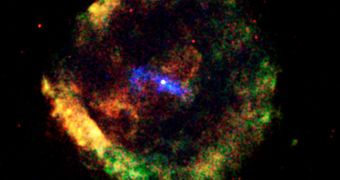A group of astrophysicists has just proposed a new mechanism for the formation of some gamma-ray bursts (GRB), which are among the most energetic phenomena in the entire Universe. The experts say that the reason some GRB last for a long time is because black holes are eating the stars emitting them.
GRB are extraordinarily-intense electromagnetic events, that see the release of tremendous amounts of high-energy radiation from the poles of dying stars that go supernova. However, this scenario alone cannot explain why the “engines” driving some GRB last for up to three days.
The NASA Swift Gamma-Ray Burst Mission was launched specifically for analyzing these cosmic events, of which we see about one per day. Every galaxy experiences only a few GRB per hundred million years.
Throughout its studies of the night sky, Swift noticed that the central jet engine that produces individual GRB operate for much longer than its burst itself does, and also longer than theoretical models can explain, Daily Galaxy reports.
This GRB-emitting dynamo may in fact be consuming stars, say investigators at the University of Leeds. They explain that there are literally very few other mechanisms through which such intense radiation levels can be produced for so long.
Black holes that form following supernova collapses may be supporting the GRB by consuming stars nearby, and converting their matter into this tremendously energetic form of light. The burst goes on for as long as the black hole needs to finish feasting.
To get an idea of how strong GRB are, let's consider the example of GRB 080916C, a burst that occurred at 7:13 pm EDT, on September 15, 2010. It was observed with the Large Area Telescope and with the Gamma-ray Burst Monitor instrument on the NASA Fermi Gamma-ray Space Telescope.
The blast was recorded in the constellation Carina, and analysis of its redshift – conducted by German researchers at the Max Planck Institute for Extraterrestrial Physics in Garching, Germany – revealed that the object in which it originated was located some 12.2 billion light years away.
“We were waiting for this one. Burst emissions at these energies are still poorly understood, and Fermi is giving us the tools to understand them,” says LAT principal investigator Peter Michelson, who is based at the Stanford University.
“Already, this was an exciting burst. But with the GROND team's distance, it went from exciting to extraordinary,” adds Fermi deputy project scientist Julie McEnery, who is based in Greenbelt, Maryland, at the NASA Goddard Space Flight Center (GSFC).
In spite of its distance, the blast was so intense that it acted as the equivalent of 9,000 supernova explosions. The matter ejected in that GRB traveled at 99.9999 percent the speed of light.

 14 DAY TRIAL //
14 DAY TRIAL //